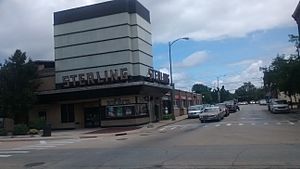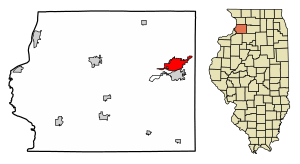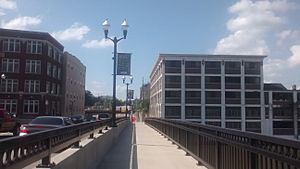Sterling, Illinois facts for kids
Quick facts for kids
Sterling, Illinois
|
|
|---|---|
 |
|

Location of Sterling in Whiteside County, Illinois.
|
|
| Country | United States |
| State | Illinois |
| County | Whiteside |
| Area | |
| • Total | 6.16 sq mi (15.96 km2) |
| • Land | 5.95 sq mi (15.40 km2) |
| • Water | 0.22 sq mi (0.57 km2) |
| Population
(2020)
|
|
| • Total | 14,764 |
| • Density | 2,483.01/sq mi (958.75/km2) |
| Time zone | UTC−6 (CST) |
| • Summer (DST) | UTC−5 (CDT) |
| ZIP Code(s) |
61081, 61082
|
| Area code(s) | 815 |
| FIPS code | 17-72546 |
| Wikimedia Commons | Sterling, Illinois |
| Website | City of Sterling Web Site |
Sterling is a city in Whiteside County, Illinois, United States. It is located along the Rock River. In 2020, about 14,764 people lived there.
Sterling was once known as the "Hardware Capital of the World." The city has a long history with manufacturing and the steel industry.
Contents
Where is Sterling Located?
Sterling is on the north side of the Rock River. Across the river is its twin city, Rock Falls. The land around Sterling is mostly flat and covered in farmland. The soil here is very fertile, making it great for growing crops.
According to the 2010 census, Sterling covers about 5.94 square miles (15.39 square kilometers). Most of this area is land, with a small part being water.
How Many People Live in Sterling?
| Historical population | |||
|---|---|---|---|
| Census | Pop. | %± | |
| 1860 | 2,428 | — | |
| 1870 | 3,998 | 64.7% | |
| 1880 | 5,087 | 27.2% | |
| 1890 | 5,824 | 14.5% | |
| 1900 | 6,309 | 8.3% | |
| 1910 | 7,467 | 18.4% | |
| 1920 | 8,182 | 9.6% | |
| 1930 | 10,012 | 22.4% | |
| 1940 | 11,363 | 13.5% | |
| 1950 | 12,817 | 12.8% | |
| 1960 | 15,688 | 22.4% | |
| 1970 | 16,113 | 2.7% | |
| 1980 | 16,281 | 1.0% | |
| 1990 | 15,132 | −7.1% | |
| 2000 | 15,451 | 2.1% | |
| 2010 | 15,370 | −0.5% | |
| 2020 | 14,764 | −3.9% | |
| U.S. Decennial Census | |||
Population in 2020
The table below shows the different groups of people living in Sterling in 2010 and 2020. This helps us understand the city's population mix.
| Race / Ethnicity | Pop 2010 | Pop 2020 | % 2010 | % 2020 |
|---|---|---|---|---|
| White alone (Non-Hispanic) | 10,855 | 9,644 | 70.62% | 65.32% |
| Black or African American alone (Non-Hispanic) | 411 | 394 | 2.67% | 2.67% |
| Native American or Alaska Native alone (Non-Hispanic) | 15 | 16 | 0.10% | 0.11% |
| Asian alone (Non-Hispanic) | 102 | 150 | 0.66% | 1.02% |
| Pacific Islander alone (Non-Hispanic) | 0 | 5 | 0.00% | 0.03% |
| Some Other Race alone (Non-Hispanic) | 20 | 37 | 0.13% | 0.25% |
| Mixed Race or Multi-Racial (Non-Hispanic) | 252 | 574 | 1.64% | 3.89% |
| Hispanic or Latino (any race) | 3,715 | 3,944 | 24.17% | 26.71% |
| Total | 15,370 | 14,764 | 100.00% | 100.00% |
In 2000, there were about 15,596 people living in Sterling. The city had 6,234 households. About 30.3% of these households had children under 18. The average household had 2.41 people.
The median age in Sterling was 36 years old. About 25.1% of the population was under 18. The median income for a household was $37,664.
Sterling's History
In 1834, a man named Hezekiah Brink built the first cabin in the area that would become Harrisburg. Two years later, William Kirkpatrick settled nearby in a place called Chatham. In 1838, Harrisburg and Chatham joined together to form the Town of Sterling. They hoped to become the county seat.
The name Sterling was chosen to honor Major James Sterling. He was a brave soldier during the Blackhawk War in 1832. On February 16, 1857, Sterling officially became a city.
Abraham Lincoln's Visit
On July 18, 1856, Abraham Lincoln visited Sterling. He spoke at a rally for presidential candidate John C. Fremont. Lincoln stayed the night at the home of Sheriff William Manahan. This home is now a preserved museum called the Lincoln-Manahan Home. Lincoln gave his speech in Propheter Park, where a statue now stands in his honor.
Growth and Industry
The Rock River was important for Sterling's growth. It powered saw and grist mills. Later, it helped power many factories. In 1856, the first train tracks were built in the area. With river power and railroads, Sterling's businesses and industries grew quickly.
In the late 1800s and early 1900s, many important companies started in Sterling. These included Northwestern Steel & Wire Co., Lawrence Brothers Inc., National Manufacturing Co., The Frantz Manufacturing Company, and the Wahl Clipper Corporation. These companies helped make Sterling a center for manufacturing.
Today, Sterling has continued to grow and change. Its industrial areas have expanded, and new business parks have been built. Sterling has become a major shopping area for the region. Outside the city, you'll still see many farms, which are common in the Midwest.
Interestingly, the cities of Sterling, Nebraska, and Sterling, Colorado, were founded by people who used to live in Sterling, Illinois. They moved west and named new towns after their old home.
Schools in Sterling
Sterling has several schools for students of all ages.
Public Schools
The Sterling Community Unit District 5 manages the public schools. These include:
- Sterling High School
- Challand Middle School
- Franklin Elementary School
- Jefferson Elementary School
- Lincoln Elementary School
- Washington Elementary School
Wallace School is Sterling's public pre-K school. Some pre-K classes are also held at Franklin and Jefferson Elementary Schools.
The Whiteside Area Career Center is next to Sterling High School. It offers many vocational courses. These courses help students learn skills for different jobs. Students from other schools in the Sauk Valley can also attend.
Private Schools
The Roman Catholic Diocese of Rockford runs two schools in Sterling:
- St. Mary's School (for both grade school and middle school)
- Newman Central Catholic High School
These schools serve students from Sacred Heart Church and St. Mary's Church.
Christ Lutheran School is a Protestant school. It is connected with the Lutheran Church Missouri Synod. This school teaches students from age 3 through 8th grade.
Parks and Recreation
Sterling has many parks for fun and outdoor activities.
Sterling City Parks
- Central Park is located at Brinks Circle.
- Dale Park is at Locust Street and 2nd Street.
- Flock Park is at Locust Street and 8th Street.
- Lincoln Park is at 16th Avenue and 4th Street.
- Platt Park is at 20th Avenue and 7th Street.
- Wallace Park is at Avenue G and 5th Street.
Sterling Park District Parks
- Douglas Park was created in 1955. It is at Chestnut Avenue and Lynn Boulevard.
- Eberley Park has 25 acres of wooded land. It opened a 1.5-mile (2.4 km) path in 1978. It is popular for jogging and walking. You can find it at Douglas Drive and West LeFevre Road.
- The Gartner Park Baseball Complex opened in 1961. It has 7 baseball fields and a playground. It is located on West LeFevre Road.
- Harry Kidd Field was acquired in 1976. It is the home field for the Sterling Jr. Tackle program for 5th-8th graders. It is at West 7th Street and Woodburn Avenue.
- The Hoover Park property was bought in 1941. It is connected to Sinnissippi Park by the S.M.A.R.T. trail system. Hoover Park is at 37th Avenue and Woodlawn Road.
- Kilgour Park was purchased in 1935. This 12-acre (4.9 ha) park was once a farm. It is now known for its Imagination Station play area, basketball, and tennis courts. It is at West LeFevre Road and Avenue F.
- Lawrence Park was acquired in 1925. It was the first park in Sterling. It has a pool built in the late 1920s. Lawrence Park is on the Avenue G Island.
- The Sinnissippi Dam Walkway and Martin's Landing opened in 2008. This walkway connects Sterling's trails to the Hennepin Feeder Canal in Rock Falls. It offers a safe and scenic route across the Rock River. Martin's Landing is the entry point to Sterling's trail system. They are located at 10th Avenue and 2nd Street (behind the Dillon Home Museum).
- Harry Oppold Marina was acquired in 1968. It has a harbor house, boat slips, picnic shelters, and playgrounds. Oppold Marina is on Stouffer Road.
- Propheter Park was donated to the Sterling Park District in 1986 by Bob Propheter. It is at 6th Avenue and East 6th Street.
- Scheid Park was acquired in 1967. It has basketball courts, a soccer field, and playground equipment. It is at Woodburn Avenue and West 11th Street.
- Sinnissippi Park is the largest park in the Sterling Park District. It was acquired starting in 1934. It is home to Hopewillian Indian Mounds, which are on the National Register of Historic Places. Sinnissippi Park is on Sinnissippi Road.
- The Skate Park was built in 2004. It was located behind the Duis Recreation Center. It was removed in 2020.
- Thomas Park was purchased in 1966. It was named after Ralph Thomas, a former park board president. It is at 12th Avenue & Lynn Boulevard. In winter, it becomes an ice hockey rink.
Famous People from Sterling
- Frances Cleveland Axtell, a legislator, was born in Sterling.
- Chris Birch, an Alaska Senator.
- Terry Brooks, a fantasy author.
- Keith L. Brown, a United States diplomat.
- Don E. Fehrenbacher, a historian, was born in Sterling.
- Paul J. Flory, a Nobel Prize winner in chemistry, was born in Sterling.
- Mike Foltynewicz, a pitcher for the Houston Astros and Atlanta Braves, was born in Sterling.
- Austin Hubbard, a mixed martial artist in the UFC, was born in Sterling.
- Jakob Junis, a pitcher for the Kansas City Royals and San Francisco Giants.
- Caroline Kent, an abstract artist, was born in Sterling.
- Dan Kolb, a pitcher for several MLB teams, was born in Sterling.
- Tim Lawson, an author.
- Joel Ryce-Menuhin, a classical pianist and psychologist.
- Michael Bryan Murphy, a musician and former lead singer for REO Speedwagon.
- Kenje Ogata, a dentist and Japanese-American WWII pilot.
- Jigar Shah, a clean energy entrepreneur.
- Jacqueline Grennan Wexler, a Roman Catholic nun and academic leader.
- Jesse Lynch Williams, who won the first Pulitzer Prize for Drama in 1918.
- Lexi Rodriguez, a former Nebraska Cornhusker volleyball player.
See also
 In Spanish: Sterling (Illinois) para niños
In Spanish: Sterling (Illinois) para niños




